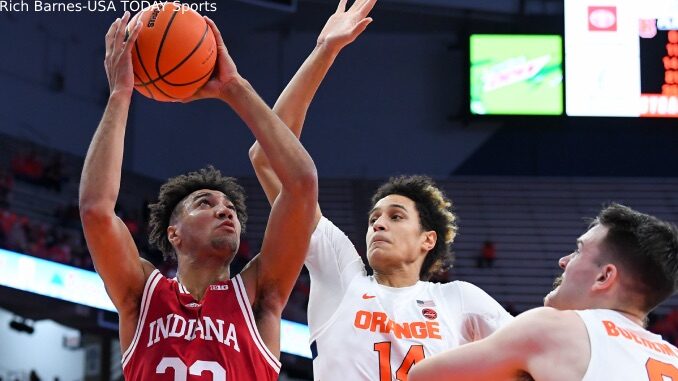
With a significant roster overhaul happening to the Syracuse basketball program, there’s probably something else that will undergo a major change – the speed the team plays at.
Last year’s group played as a slightly faster pace than the national average, as did the previous year’s squad. That moderate tempo had become a bit of a trend as the team leaned into shooting three-pointers and going for more offensive punch as the Orange defense was not as strong as it had been for most of the previous decade.
While it is far too early to write anything into stone, next year’s roster is mostly devoid of proven offensive firepower. Joe Girard III is just outside the top 50 in all-time scorers at SU with 1,126 points in his career and Jesse Edwards posted in double figures 16 times last season before he went on the shelf due to injury.
After that, the cupboard is pretty bare.
While logging the most playing time in his three collegiate seasons in his first year at SU, Symir Torrence also set a personal high-water mark in single-season scoring… with 77 points. Playing starter’s minutes in the final two games, Torrence tallied 16 of those markers. Benny Williams had 14 points late in the regular season against Duke, suggesting he was finally getting comfortable on the floor, but just 42 points beyond that in his freshman campaign.
At the start of the season, Jon Bol Ajak’s seven career points will rank fifth on the roster, should it remain in its current state.
Girard will undoubtedly draw a ton of defensive attention. Edwards did a lot of his work this past season with the starters, running a lot of four-out offensive sets with three prolific outside shooters in Buddy Boeheim, Girard, and Cole Swider and another player who often set up outside in Jimmy Boeheim. With three of those four out the door, Edwards is not likely to get lots of open space in the paint with the same frequency next season.
So, with a less explosive offense, it would make sense that the team would try to slow things down, grind out defensive stops with a more athletic version of the zone, and pull out some lower-scoring affairs. The 2-3 zone should definitely be better with Edwards’ experience from last season helping him grow into as a stronger defensive backbone.
After all, another part of Edwards game that developed this past season with a lower level of fanfare was his defense, particularly his presence as a shotblocking threat. Edwards blocked 67 shots in 668 minutes of play, more than the rest of the roster combined. The center blocked at least one shot in every game and notched four or more five times, three of them coming in conference play. (This focus on shotblocking would also explain the Orange staff’s ultimately unsuccessful efforts to coax Quincy Ballard from the transfer portal and into a backup center role.)
» Related: How did Syracuse’s NBA players do this year?
Edwards’ 67 blocks in his injury-shortened season was the highest for any SU player since Paschal Chukwu swatted 91 shots during the 2017-2018 campaign. In that season, Chukwu was joined by a high-scoring two-guard (Tyus Battle), a point guard who handed out 175 assists while not being a great shooter (Frank Howard), and a couple very young forwards (Oshae Brissett, Marek Dolezaj) making contributions en route to the Sweet Sixteen.
That team also played at one of the slowest paces in college basketball, ranking 345th in adjusted tempo at KenPom. It also was coming off a season as what was statistically the worst defense at Syracuse in who knows how long with a team that relied on three-point shooting, but failed to make the NCAA Tournament.
Next year’s team will feature that shotblocking center in the middle in Edwards, get offense from a high-scoring two-guard in Girard, have a pass-first point who needs work on his jump shot in Symir Torrence, and very likely need contributions from a pair of young forwards in Chris Bunch and Williams.
The 2017-18 squad eked into the NCAA Tournament, earning a spot in one of the play-in games. From there, they won three games by a total of 11 points, never once posting more than 60 points in a single game, before getting bounced in the Sweet Sixteen.
While it is no guarantee that the Orange will ease off the gas next season, there are plenty of similarities right there. It may not be as exciting as last season’s squad, but next year’s Orange have a blueprint to be more successful.
For more Syracuse coverage, like us on Facebook, follow us on Twitter and Instagram, and listen to our podcast.

